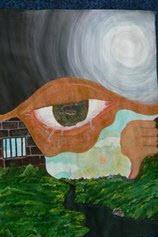In January the acquired brain injury charity Headway launched an exhibition of the art work completed in their rehabilitative arts program. The exhibition is in Dudley, in the heart of the Black Country. The charity Headways provides services for people with acquired brain injuries, their families and their carers in the four Black Country Boroughs – Dudley, Sandwell, Walsall and Wolverhampton.
Headway Black Country is a unique body in its diversity of services and its intent to meet the social, educational, medical and creative needs of people with aqcuired brain injuries Since it was set up in 1997, Headway Black Country has pioneered innovative therapeutic programs.
Rehabilitative group sessions are provided on their premises in Dudley for two sessions per day, morning and afternoon, on four days a week, Monday to Thursday. For Wolverhampton residents with acquired brain injury, they provide an outreach service in Wolverhampton on one day per week for two sessions, working on cognitive rehabilitation.
At present the Dudley rehabilitative groups are ranged in focus from Computer Skills, Social and Creative Art, Creative Expression (supporting people who have difficulty with communication), Cognitive and Life Skills to Social Interaction and Communication.
Depending on which lobe is damaged due to cessation of blood or haemmorhage, a whole range of difficulties can result from a traumatic brain injury. These can vary from being very visible to being subtly destabilising, and can pass unnoticed until a crisis point is reached. Many injuries occur in motor and sports accidents, or following such incidents as cardiac arrest or strokes and some from viral infections such as encephalitis.
Seizures, personality changes, mood swings, loss of memory, bursts of rage, eye problems and failure of muscular co-ordination are some of the symptoms that an acquired brain injury survivor may face and want to address in the process of rehabilitation.
The recently acknowledged possibility of regrowth of brain cells has placed art therapy as a vital force in helping people recover from brain injuries and to help people make sense of a world again which may have considerably perceptually shifted. The benefits to people of art therapy is a living example of the power and value of collaborative relationships that can exist between art and medicine.
A growing body of literature demonstrates the effectiveness of art therapy. Some of these benefits include increased dexterity and hand eye-coordination, improved initiation of sequential activities, increased social ease, longer periods of focus, increased stamina and a reduction of agitation. Clinical data has demonstrated that the images produced in making art help externalize and resolve internalized fears, conflicts and blocks.
On January 2nd, the Mayor of Dudley opened the Headways exhibition of art at the Netherton Arts Centrecreated. In addition to the benefits the artists receive as regards to confidence, self-esteem, creative merit bursts through the works. This fountain of artistic talent that flows is perhaps attributable to the qualities of disinhibition and creative connectedness that many brain injury survivors display.
Artist Georgia Belfont has been the facilitator of the arts program at Headways. One of the works that Georgia Belfont is most well-known for is Re-evaluating Olympia; a painting which looked at how black women have been portrayed in European art history.
Belfont’s work raises awareness that some views in art have historically dominated to the detriment of others. It is perhaps therefore no coincidence that in this part of her career she is to be found championing the creativity of a demograph whose creative insights are frequently marginalized.
Historically many artists have struggled with challenging psychological conditions. The Surrealist movement, and in particular Andre Breton and Jean Dubuffet were keen admirers of artists who had perceptual variations from the “norm” and increasingly it would appear that an widening appreciation of art is growing as regards the work of people with all variations of intellecutual ability.
The Art Therapy Studio in Cleveland, Ohio in the US, is a similarly important organisation to Headway Black Country in promoticing understanding of the importance of arts programs ot people with acquired brain injuries. The ATS has been working with the local health centre MetroHealth for the last 40 years providing art based rehabilitation programs. In their promotional material they state:
“The integrating process of creating an image with paint or clay helps put the pieces back together and makes connections to who we are and what we feel when nothing else seems to work.” Art Studio Therapy website.
On the Headway website, people who have used the Black Country services have contributed testimonials about the importance of the organization to their quality of living. One brain injury survivor writes:
“I think it is just a superb organisation and I feel very grateful to have a place here. I enjoy it as: number one: It is my big day out – a reason to get up and ready and take care about what I wear and how I look and feel. Number two: it is a place to come and be with lovely people in a similar circumstance who understand exactly where one is or might be coming from, on any topic ator on any level. Number three: I find it very informative on MANY levels but most especially the way it enables me to understand and come to terms with my brain injury and my “new life”. It’s not so scary after all! I can live with this…..on and on and on and on…”
The Headway’s exhibition reasserts the vital fact that for survivors of acquired brain injuries working together in arts contexts promotes interaction with other people and a gentle way to gain self-understanding. Furthermore, it results in the most beautiful, emotionally unmasked art works filled with symbolic weight and sincere intent that help all viewers to gain insight into the experiences of a too often marginalised and unheard sectors of the community.
Headway Exhibition
Dates: 01 Jan 2010 – 31 Mar 2010
Venue: Netherton Arts Centre, Northfield Road, Netherton, Dudley, DY2 9ER. 01384 812846
Headway Black Country
Address: 198 Wolverhampton Street, Dudley, West Midlands, DY1 1DZ
Tel: 01384 869961
Fax: 01384 869962
For more information visit the Headway Black Country website here.




